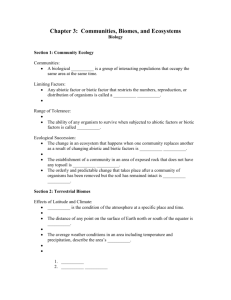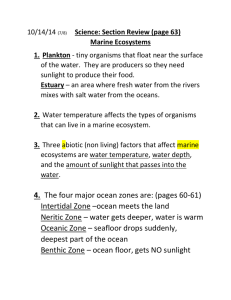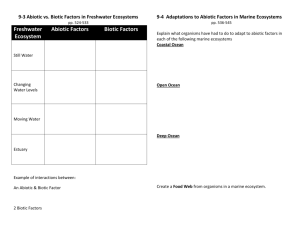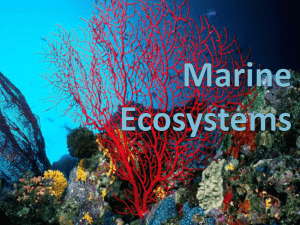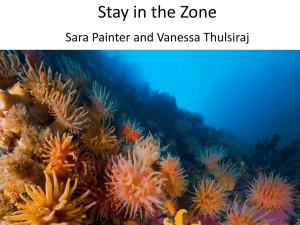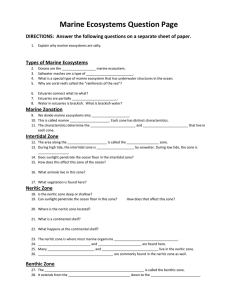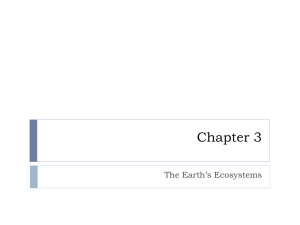Study Notes for Chapter 3 Section 1: Land Biomes
advertisement
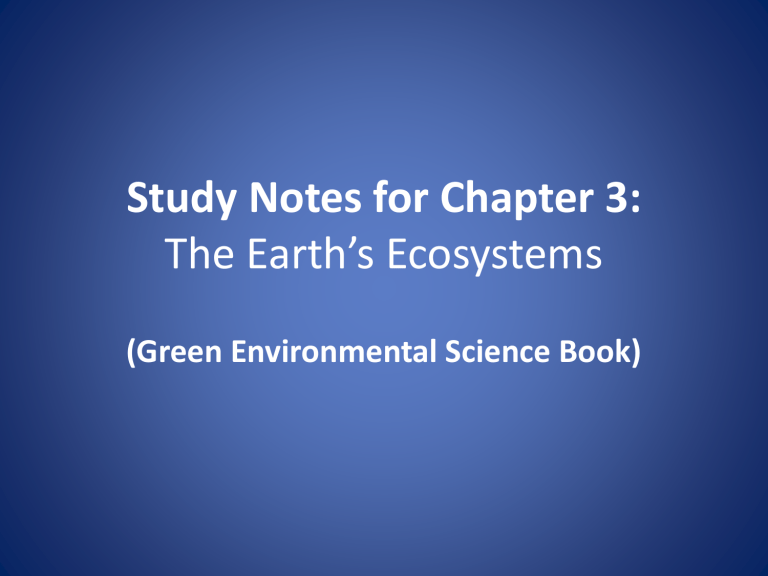
Study Notes for Chapter 3: The Earth’s Ecosystems (Green Environmental Science Book) Chapter 3 Section 1: Land Biomes 1. _______ Abiotic factors are the nonliving parts of an environment. 2. ______ Biotic factors are the living parts of an environment. 3. __________ Coniferous forests have tall trees full of leaves year-round. Tropical ____ Rain forests has many 4. _______ trees and receives up to 400 cm of rainfall per year. Tropical Rain 5. _______ ____ forests have very poor soil. 6. During the summer, _________ savanna grasses dry out and turn yellow. 7. A ______ desert is very dry and often very hot. 8. __________ Permafrost is soil that is always frozen. Chapter 3 Section 2: Marine Ecosystems 1. Water temperature, depth, and abiotic factors amount of sunlight are ______ of a marine ecosystem. 2. __________ Plankton are tiny organisms that float near the surface of the water and produce their own food. 3. The base of the ocean’s food chains is formed by ________. plankton 4. The _______ surface zone has the warmest temperature. Intertidal zone is where the 5. The _________ ocean meets the land. 6. Animals living in the _________ intertidal zone must adapt to crashing waves and exposure to air. 7. The ________ neritic zone is where the ocean floor begins to slope downward, with warm, sunlit water. 8. Coral reefs, Sea turtles, and dolphins live in the _______ neritic zone. 9. In the _______ oceanic zone the sea floor drops ________ sharply and contains the deep water of the open ocean and animals such as whales and sharks. 10. The _______ benthic zone is the ocean floor where the deepest parts get no _______. sunlight benthic 11. Animals that live in the ________ sinks from zone eat material that _____ above. 12. Oceans provide most of the water for ____________ precipitation on Earth. Coral_____ reefs are very biologically 13. ____ diverse compared with other marine ecosystems. 14. An area with nutrient-rich, fastmoving _____-water from rivers that fresh spills into the ocean is called an estuary _______. 15. The nutrient-rich waters near polar ice _____ ___ supports large numbers of plankton. Chapter 3 Section 3: Freshwater Ecosystems abiotic factor that affects 1. A major _______ freshwater ecosystem is speed of adapt water because animals must ______ so they are not washed away. 2. Many plants can grow in the littoral zone of a lake because ________ sunlight reaches its bottom. 3. _________ Wetlands are ecosystems that play an important role in flood control. 4. _________ Wetlands help replenish underground water supplies because water moves deeper in the ground. marsh is an area near the shore 5. A _______ of a pond with many grasses and no trees. swamp is an area with wet soil, 6. A _______ standing water, with willows and orchids. 7. A ____ lake may become a forest when sediment over time. it fills with _________ The End

